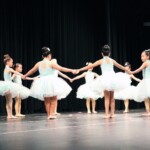Core Dance Techniques: Strengthening Your Foundation for a Better Performance
Whether you’re a beginner just starting out in dance or an experienced performer seeking to refine your skills, focusing on core dance techniques is essential for improving performance. Just like in any sport, a strong foundation in the basics provides dancers with the stability, control, and confidence needed to master more complex moves. In this blog, we’ll explore the key techniques that can help you strengthen your core, enhance your performance, and elevate your dance practice to new heights.
1. Posture: The Bedrock of Control
Good posture is the foundation of every dance form, from ballet to hip-hop. Proper alignment ensures that your body moves with efficiency and grace while minimizing the risk of injury. When your posture is correct:
- Your shoulders are relaxed but aligned with your hips.
- Your core is engaged to support your spine.
- Your head is balanced over your spine, with your chin parallel to the floor.
By practicing strong posture daily, you set the stage for balance, flexibility, and endurance, allowing your movements to flow smoothly.
2. Core Strength: The Powerhouse of Movement
The core is where all your power originates in dance. It controls balance, stability, and the energy needed for executing precise movements. Strengthening your core allows you to:
- Improve balance during spins, turns, and jumps.
- Maintain control during complex sequences.
- Build endurance, making you less prone to fatigue during long performances.
Dancers can benefit from exercises like planks, Pilates, and leg lifts, which target the abdominals, obliques, and lower back muscles. A strong core also helps prevent injuries by stabilizing your body in demanding positions.
3. Flexibility: Expanding Your Range of Motion
Flexibility enhances the grace and fluidity of your movements. Being able to stretch fully in your dance sequences improves your ability to express the choreography and adds a polished aesthetic to your performance. Key areas to focus on include:
- Hamstrings and Quadriceps: These muscles help with jumps and extensions.
- Hip Flexors and Rotators: Vital for turnout in ballet and leg lifts in contemporary dance.
- Shoulders and Back: Flexibility here helps with port de bras, arm movements, and spins.
To build flexibility, dynamic stretching before practice and static stretching afterward will help increase your range of motion and prevent stiffness.
4. Balance: The Art of Precision
Balance is integral to dance, especially when performing spins, leaps, or jumps. Without good balance, even the simplest moves can feel unstable and wobbly. Key elements of improving balance include:
- Focus: Keeping your gaze fixed on a point during turns (spotting) helps prevent dizziness.
- Engaged Core: Maintaining a tight core while dancing stabilizes your body and enhances balance.
- Weight Distribution: Shifting weight smoothly between movements helps keep you grounded.
Incorporating balancing exercises, such as practicing relevés or standing on one leg, will improve your ability to stay centered.
5. Coordination: Synchronizing Movement with Music
Coordination involves syncing different parts of your body in harmony, allowing you to move fluidly through a routine. It also means connecting your movements with the rhythm and flow of the music. To enhance coordination:
- Practice Musicality: Focus on timing and rhythm by working on counting beats and staying in sync with the music.
- Break Down Movements: Isolate body parts (arms, legs, head) during rehearsals to perfect each aspect before integrating them into full-body movements.
- Repeat Patterns: Repetition improves muscle memory, making complex choreography feel more natural.
6. Strength: Boosting Power and Endurance
Strength is crucial for explosive movements like jumps, lifts, and fast footwork. Building strength, especially in your legs and arms, helps you execute these moves with power and grace. Some effective strength-training exercises for dancers include:
- Squats and Lunges: For leg strength and stability.
- Push-ups and Tricep Dips: To build upper-body strength for partnering work or arm movements.
- Resistance Band Workouts: To strengthen the smaller muscles that contribute to balance and precise movements.
7. Footwork: Refining Precision
Precision in footwork enhances overall performance and makes your dancing appear sharp and clean. Whether you’re working on tap steps, ballet pointe work, or hip-hop footwork, focus on:
- Quickness: Practice drills to improve speed.
- Accuracy: Make sure each step is placed correctly.
- Fluid Transitions: Work on the flow from one step to the next without stumbling or hesitating.
Conclusion
Mastering core dance techniques is essential for any dancer aiming to perform with control, power, and artistry. By prioritizing posture, core strength, flexibility, balance, coordination, strength, and footwork, you create a solid foundation for more complex choreography. Consistent practice and attention to these key elements will lead to noticeable improvements in your performance, helping you become a more confident and capable dancer.
So, whether you’re training for a professional performance or dancing for fun, remember: a strong foundation is the key to unlocking your potential. Keep refining those core techniques, and you’ll see the difference in every movement you make!
Learn more about Dance Classes here!
Signing up for lessons is easy!
- Send us more information about your goals
- Register with us now!
- Give us a call at (402) 576-5792



